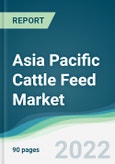Commercial cattle feed is either provided directly to the animals or mixed with feed concentrates or roughages before feeding. "Compound feed is a mixture of products of vegetable or animal origin in their natural state, fresh or preserved, or products derived from industrial processing thereof, or organic or inorganic compounds for oral feeding in the form of a full diet, whether or not containing additions," according to the FAO. Specific formulations created according to each growth period of the cattle are used to compound commercial feed to be fed as a sole ration. Beef cattle, dairy cattle, calves, and other livestock are fed compound cattle feed. Factors such as increased demand for cattle meat, processed meat, and milk products, particularly in developing nations such as China and India, are boosting the cattle feed industry. The expansion in meat mass production is the primary driver of this market. Additives are used to help cattle produce more milk and improve the quality of their meat. The additions also help to boost the feed's nutritional content and palatability. Antioxidants, vitamins, antibiotics, amino acids, feed enzymes, and feed acidifiers are some of the popular feed additives.
Market Trend
With updated technology, the Chinese cow feed and feed additives market has the potential to grow soon, resulting in increased cattle feed consumption. Furthermore, the rise of the Indian cow feed market results from the dairy industry's industrialization and rising consumption of dairy products. Thailand, New Zealand, Australia, South Korea, and Vietnam are among the other nations in the Asia-Pacific region, driving market expansion in cattle feed and feed additives. Cow feed is one of the most important parts of cattle health since it has a direct relationship with animal husbandry production and results. Moreover, during the projected period, an increased focus on cattle health to prevent disease is expected to improve the demand for cattle feed in this region.
Furthermore, increased disposable income and fast urbanization are expected to enhance demand for high-quality cattle products in the coming years, boosting demand. Moreover, the region's shrinking grazing land is likely to increase the demand for cattle feed.
Growth Factors
Demand for animal protein is increasing.
Due to shifting dietary trends, urbanization, population increase, and economic growth, the Asia-Pacific area has one of the greatest rates of meat consumption growth. In recent years, there has been a growing public awareness of the health benefits of protein consumption. This resulted in various changes in dietary habits and consumption patterns, including a move toward increasing consumption of meat and dairy products. Consumers are more concerned about their health; thus, they are focused on nutrient-dense products obtained from calves fed enriched feed. This rising demand for various animal products is helping to drive the ruminant feed market in this region forward.
China dominates the cattle feed market
Cattle feed additives and organic feed are becoming more popular in China as the country's cattle feed consumption rises. Manufacturers are coming up with new ways to enhance production capacity while lowering prices. Feeding bovine animals is difficult in oceanic regions like Australia, compared to India, where cheaper ruminant alternative goods are abundantly available. Ruminant feeding has become popular in developing countries like India because it lowers feed costs for livestock producers in two ways: first, it improves the digestive system of cattle through pH shifts and metabolic modifications, and second, it improves and maintains the animal's growth by providing essential nutrients like amino acids and vitamins. Furthermore, the region's demand for ruminant feed is driven by a growing population, rising per capita meat consumption, and increased adoption of intensive farming methods.
Restraint
Disease Outbreaks and Unprecedented Price Hikes to wreak havoc on the cattle feed market.
Farm animals' immunity is neutralized by unsafe and contaminated feed ingredients, resulting in a loss of productivity for farmers. As disease outbreaks have become more regular, livestock producers have invested in high-quality feed premixes. Customers have placed a great value on product safety and quality assurance. Diseases can impact the trade of livestock goods like dairy, meat, and by-products. For a long time, the illness-affected areas are prohibited from exporting these products until the disease has been entirely isolated and managed.
Impact of COVID-19 Pandemic:
The pandemic and its accompanying lockdown have not only caused enormous distress to millions of poor and marginal farmers who were trying to save their crops and/or livestock to ensure their livelihoods, but it has also had an impact on the overall poultry, dairy, and other livestock production systems and value chains, nutrition, and health care, and labor availability. Many livestock feed companies are having trouble getting feed raw materials and packing ingredients consistently. Truck transit between states has been restricted, and labor shortages have been observed.
Segmentation:
By Raw Material
- Soya
- Corn
- Wheat
By Countries
- China
- Japan
- India
- South Korea
- Indonesia
- Vietnam
- Others
Table of Contents
Companies Mentioned
- Cargill Corporation
- Biomin
- AllTech Inc.
- Archer Daniels Midland
- BASF SE
- Charoen Pokphand Foods PCL
- New Hope Group
- Adisseo
- Godrej Agrovet
- De Hues
Table Information
| Report Attribute | Details |
|---|---|
| No. of Pages | 90 |
| Published | July 2022 |
| Forecast Period | 2020 - 2027 |
| Estimated Market Value ( USD | $ 12955.42 million |
| Forecasted Market Value ( USD | $ 16387.72 million |
| Compound Annual Growth Rate | 3.4% |
| Regions Covered | Asia Pacific |
| No. of Companies Mentioned | 10 |









